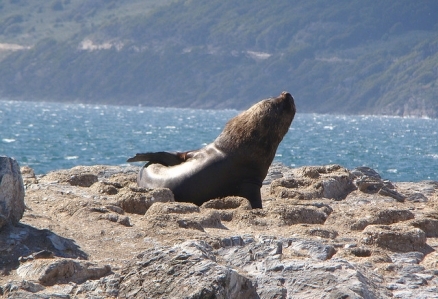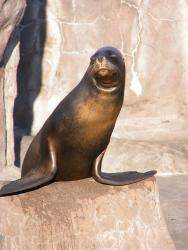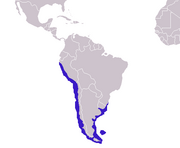South American sea lion
The South American sea lion (Scientific name: Otaria flavescens - also Otaria byronia) is one of 16 species of marine mammals in the family of Eared seals which include sea lions and fur seals. Together with the families of true seals and Walruses, Eared seals form the group of marine mammals known as pinnipeds.
Eared seals differ from the true seals in having small external earflaps and hind flippers that can be turned to face forwards. Together with strong front flippers, this gives them extra mobility on land and an adult fur seal can move extremely fast across the beach if it has to. They also use their front flippers for swimming, whereas true seals use their hind flippers.
South American sea lions are not presently threatened. They experienced a large population decline during the past 70 years in the Falkland Islands. The reason for this abrupt decline is unknown. Though they are not currently threatened, they are protected throughout most of their range.
|
Conservation Status |
|
Scientific Classification Kingdom: Animalia (Animals) |
| Common Names Southern Sea Lion Patagonian Sea Lion Maned sea lion South American sea lion |
Contents
Physical Description
South American sea lions are the most sexually dimorphic of the five known sea lion species. Males are approximately three times the size of females.
Adult males range from 2 to 2.5 meters in height and can weigh from 200 to 350 kilograms. The coat is dark brown on the dorsal side and dark yellow to gold on the ventral side. Males have a full mane, which is a paler color than the coat and a larger, more muscled neck than do females. A male's posture is usually upright, with the rostrum turned upward.
Adult females are much smaller in size and weight. They average 2 meters in height and can weigh from 140 to 150 kilograms, roughly half the average weight of an adult male. Their coats are also lighter in color relative to males. Coat color ranges from a fair brown to yellow with some pale markings around the head.
Pups do not exhibit this brown color until about a month after they are born. Neonates are greyish orange ventrally and black dorsally. This coat later turns to a dark chocolate brown color. Sexual dimorphism is shown in pups as well as in adults. According to a study in Peninsula Valdes, Argentina, male pups averaged 0.82 meters in length and 13.7 kilograms in weight. In contrast, female pups averaged 0.79 meters in length and 12.3 kilograms in weight
Reproduction
The South American sea lion is known for its polygynous lifestyle. Mating season occurs from early August to December, when males defend territories aggressively and show interest in females. Mating behavior includes mutual vocalizations, snout and mouth contact, smelling, and playful biting. Territories for breeding grounds are usually on beaches of sand, pebbles, or flat rock. Males prevent females from leaving the beaches until they have mated.
Birth occurs from mid-December to early February in the year after mating, with the bulk of births during mid-January. The gestation period is about 11.75 months. There is typically one pup per birth, which averages 0.80 to 0.85 meters in length and 10 to 15 kilograms in weight. Male pups tend to be larger than females. However, since mothers seem to not show any gender-based nursing difference, the gender bias in parental investment occurs only during gestation. The heightened maternal investment in male offspring is important for their reproductive success, as size is important to males in establishing their mating territories.
Mothers fast for 5 to 7 days after giving birth in order to nurse their pup. Soon after giving birth mothers enter oestrus and mate again with the male in whose territory they have given birth. After mating, the mother leaves her pup behind to find food in the sea.
Since individuals mate and breed synchronously with hundreds of other sea lions, pups are protected from both predators and abduction when the mother is away, as they are not left "alone" on the beach. The simultaneous birthing system also promotes group bonding among pups.
There are some negative consequences to mass birthing also. It triggers the mother's aggression level toward other female sea lions in defense for her pup. Mothers return from their feeding trips in intervals to nurse their young. A female is able to locate her pup by first calling to it and finally identifying it by smell.
Sometimes a mother is separated from her pup and is not successful in finding it. This occurs as a result of several factors such as high tide, storms, male abductions, and inexperience of a young mother.
Pup mortality can range from 2 to 50%, depending on the size of the population. Larger populations experience higher pup mortality because of the greater risk of pups being trampled to death by adult sea lions. Pup mortality can be due to predators (such as pumas), diseases, parasites, drowning, subadult males, and starvation (when they lose their mothers).
Pups spend most of their time in groups or pods playing, sleeping, or residing near the water. They rarely swim into the deeper waters unless accompanied by their mothers. They typically first enter the water at about 3 to 4 weeks of age with other sea lions in a large group. They continue to nurse for about 6 to 12 months, until the mother gives birth to another pup. Even then, mothers have been known to nurse both pups simultaneously.
Male pups mature later than female pups. Male pups reach maturity at 6 years of age, whereas females mature at 4 years of age. Both sexes reach their full adult size around 8 years of age.
During development, mothers must be aware of group raids by invading males, who abduct their pups. These raids can take place at any time of the day or night but are correlated with the number of females in oestrus, their location, and the tide level. Raiding and abudction of pups may be timed to occur early during the female's oestrus, in order to attract mothers away from their terrritory for mating purposes. These raids may also signify strength and power. Some pups are killed by the males during raids. Mothers do not usually leave grounds and try to retrieve a pup if it is abducted. The mother is helpless in fighting the male because of his much larger size. Some researchers have suggested that males abduct pups to gain practice in controlling females during the mating season.
Lifespan/Longevity
The average lifespan of Southern American sea lions is 16 to 20 years. One captive sea lion, at the Valley Zoo, in Edmonton, Canada, is 30 years old (in 2008).
Behavior
The South American sea lion is a social, group living species. Groups usually consist of multiple females and one to several males who defend the territory. Males, called bulls, actively patrol their grounds, threaten intruders, and advertise their territorial boundaries through vocalizations. However, fights between the bull and any intruder are rare unless the intruder tries to take over the territory.
Fights are most prominent between two bulls during the initial phase of the breeding season. The number of fights between males increases as the number of females in heat increases. Bulls let out vocal grunts and attack each other by biting and tearing. During these fights, many pups are stepped upon and killed. Bulls may maintain their territories for 2 to 3 mating seasons before another bull takes over.
A bull's territory is highly dependent on the presence of cows rather than topological features or size. Each bull typically has 18 cows in his territory. Females tend to chose tidepool areas where temperature is not over 30 degrees Celsius. These thermoregulatory factors and topological features affect breeding behavior in females, and thus indirectly affect features of bull territories.
Young males who have not yet been able to obtain females usually live with other young males in groups of 10 to 40 individuals. Males in these groups attempt to raid established male territories in order to obtain females.
The South American sea lion also shows behavioral responses to thermal changes. When the temperature gets too cold, these sea lions position their bodies so that mimimal surface area is exposed to the air. An individual may lie on its bellywhile covering its forepaws. When it gets too warm, individuals may lie belly up with one hindfoot projected outwards.
Distribution
South American sea lions inhabit South American coastlines from Rio de Janeiro (23 degrees south latitude) on the Atlantic ocean side and coastal Perú (5 degrees south latitude) on the Pacific coast to southernmost South America. There are records of South American sea lions inhabiting the Galapagos and Falkland Islands.
Habitat
South American sea lions reside along shorelines and beaches. These beaches usually consist of sand, gravel, rocks, and/or pebbles. They also inhabit flat rocky shelves or cliffs with tidepools and boulders.
Food Habits
South American sea lions are carnivorous. They feed on fish, cephalopods, crustaceans, and other invertebrates depending on local abundance. These sea lions are typically found hunting in shallower waters, not more than five miles from shore. When looking for prey that travel in schools they hunt in groups. When they catch fish, they usually shake the prey in the air and then sometimes eat it whole. In addition, they have been observed eating penguins and female South American fur seals (Arctocephalus australis) and their pups. Their predators include pumas, sharks, and killer whales.
Conservation Status
South American sea lions are not presently threatened. They experienced a large population decline during the past 70 years in the Falkland Islands. The reason for this abrupt decline is unknown.
Though they are not currently threatened, they are protected throughout most of their range.
The IUCN rates the species at "Least Concern."
Economic Importance for Humans
Until recently South American sea lionswere hunted fortheir fur, meat, and oil. South American sea lions will steal fish from human fishing grounds by following fishing boats and stealing fish from the nets.
Further Reading
- Otaria flavescens Encyclopedia of Life (accessed April 8, 2009)
- Otaria flavescens,Liu, S., 2000, Animal Diversity Web (accessed April 9, 2009)
- South American Fur Seal, Seal Conservation Society (accessed April 8, 2009)
- The Pinnipeds: Seals, Sea Lions, and Walruses, Marianne Riedman, University of California Press, 1991 ISBN: 0520064984
- Encyclopedia of Marine Mammals, Bernd Wursig, Academic Press, 2002 ISBN: 0125513402
- Marine Mammal Research: Conservation beyond Crisis, edited by John E. Reynolds III, William F. Perrin, Randall R. Reeves, Suzanne Montgomery and Timothy J. Ragen, Johns Hopkins University Press, 2005 ISBN: 0801882559
- Walker's Mammals of the World, Ronald M. Nowak, Johns Hopkins University Press, 1999 ISBN: 0801857899
- South American fur seal, MarineBio.org (accessed April 8, 2009)



